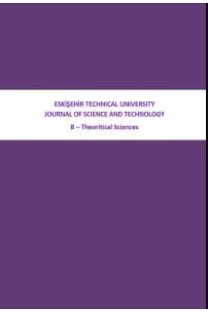EKSİK VERİLERİ TAMAMLAMADA DERİN ÖĞRENME TEMELLİ YAKLAŞIM
derin öğrenme, oto-kodlayıcı, gürültü giderici oto-kodlayıcı, eksik veri
DEEP LEARNING-BASED APPROACH FOR MISSING DATA IMPUTATION
Deep learning, auto-encoder, denoising auto-encoder, missing data,
___
- Şeker A, Diri B, Balık HH. Derin Öğrenme Yöntemleri ve Uygulamaları Hakkında Bir İnceleme Gazi Mühendislik Bilimleri Dergisi 2017; 3:47-64.
- Ballard DH. Modular Learning in Neural Networks. In: AAAI, 1987. pp 279-284.
- Qiu YL, Zheng H, Gavaert O. A deep learning framework for imputing missing values in genomic data. bioRxiv:406066 2018.
- Ahmed H, Wong M, Nandi A. Intelligent condition monitoring method for bearing faults from highly compressed measurements using sparse over-complete. features Mechanical Systems and Signal Processing 2018; 99:459-477.
- Ishii T, Komiyama H, Shinozaki T, Horiuchi Y, Kuroiwa S. Reverberant speech recognition based on denoising autoencoder. In: Interspeech 2013; pp 3512-3516.
- Del Testa D, Rossi M. Lightweight lossy compression of biometric patterns via denoising autoencoders. IEEE Signal Processing Letters 2015; 22:2304-2308.
- Tan CC, Eswaran C. Using autoencoders for mammogram compression. Journal of medical systems 2011; 35:49-58.
- Sakurada M, Yairi T. Anomaly detection using autoencoders with nonlinear dimensionality reduction. In: Proceedings of the MLSDA 2014 2nd Workshop on Machine Learning for Sensory Data Analysis 2014; p 4.
- Chen J, Sathe S, Aggarwal C, Turaga D. Outlier detection with autoencoder ensembles. In: Proceedings of the 2017 SIAM International Conference on Data Mining 2017; pp 90-98.
- Hinton GE, Salakhutdinov RR. Reducing the dimensionality of data with neural networks science 313:504-507.
- Lu X, Tsao Y, Matsuda S, Hori C. Speech enhancement based on deep denoising autoencoder. In: Interspeech 2013; pp 436-440.
- Vincent P, Larochelle H, Bengio Y, Manzagol P-A. Extracting and composing robust features with denoising autoencoders. In: Proceedings of the 25th international conference on Machine learning 2008; pp 1096-1103.
- García-Laencina PJ, Sancho-Gómez J-L, Figueiras-Vidal AR. Pattern classification with missing data: a review. Neural Computing and Applications 2010; 19:263-282.
- Duan Y, Lv Y, Kang W, Zhao Y. A deep learning based approach for traffic data imputation. In: Intelligent Transportation Systems (ITSC), 2014 IEEE 17th International Conference on 2014; IEEE, pp 912-917.
- Duan Y, Lv Y, Liu Y-L, Wang F-Y. An efficient realization of deep learning for traffic data imputation. Transportation research part C: emerging technologies 2016; 72:168-181.
- Gondara L, Wang K. Recovering loss to followup information using denoising autoencoders. In: 2017 IEEE International Conference on Big Data (Big Data) 2017; pp 1936-1945.
- Gondara L, Wang K Mida. Multiple imputation using denoising autoencoders. In: Pacific-Asia Conference on Knowledge Discovery and Data Mining 2018; pp 260-272.
- Beaulieu-Jones BK, Moore JH. Missing data imputation in the electronic health record using deeply learned autoencoders. In: PACIFIC SYMPOSIUM ON BIOCOMPUTING 2017.;World Scientific, pp 207-218.
- Zhao L, Chen Z, Yang Z, Hu Y, Obaidat MS. Local similarity imputation based on fast clustering for incomplete data in cyber-physical systems. IEEE Systems Journal 2018; 12:1610-1620.
- Shao M, Ding Z, Fu Y. Sparse low-rank fusion based deep features for missing modality face recognition. In: Automatic Face and Gesture Recognition (FG), 2015 11th IEEE International Conference and Workshops on 2015; pp 1-6.
- Tran L, Liu X, Zhou J, Jin R. Missing Modalities Imputation via Cascaded Residual Autoencoder. In: Proceedings of the IEEE Conference on Computer Vision and Pattern Recognition 2017; pp 1405-1414.
- Malek S, Melgani F, Bazi Y, Alajlan N. Reconstructing Cloud-Contaminated Multispectral Images With Contextualized Autoencoder Neural Networks IEEE Transactions on Geoscience and Remote Sensing 2018; 56:2270-2282.
- Ning X, Xu Y, Gao X, Li Y. Missing data of quality inspection imputation algorithm base on stacked denoising auto-encoder. In: Big Data Analysis (ICBDA), 2017 IEEE 2nd International Conference on, 2017. IEEE, pp 84-88.
- ISSN: 2667-419X
- Yayın Aralığı: Yılda 2 Sayı
- Başlangıç: 2010
- Yayıncı: Eskişehir Teknik Üniversitesi
KİMYASAL ANKRAJLARDA KENAR MESAFESİ VE GÖMME DERİNLİĞİNİN ETKİSİ
MÜŞTERİ HİZMETLERİ BÖLÜMÜNDE SÜREÇ ANALİZİ VE STRATEJİK PLANLAMA- LASTİK SEKTÖRÜNDE BİR UYGULAMA
İrem UÇAL SARI, Duygu SERGİ, Semih Faruk ÖZUDURUK
YIKICI SİSMİK YÜKLER ALTINDA SİLİNDİRİK ÇELİK SU TANKLARININ DOĞRUSAL OLMAYAN ANALİZİ
Ali İhsan ÇELİK, M. Metin KÖSE, Tahir AKGÜL, Ahmet Celal APAY
BİR METİN MADENCİLİĞİ UYGULAMASI: VOSVIEWER
GENTAMICIN YÜKLENEN PCL NANOFİBERLERİNİN ÇEŞİTLİLİK HÜCRESİNE ETKİSİ VE PLAZMİD DNA ORANI
Muhammet CEYLAN, Shang-you YANG, Ramazan ASMATULU
STABILITY CRITERIA FOR RETARDED FUNCTIONAL DIFFERENTIAL EQUATIONS
Ali Fuat YENİÇERİOĞLU, Cüneyt YAZICI
MERKEZİ BİR DEPO İÇİN GÜNLÜK SEVKİYAT PLANLAMASI
BASINÇ VE VOLTAJIN KÜRESEL PLAZMA ODAK CİHAZI DİNAMİ ÜZERİNE ETKİSİ
